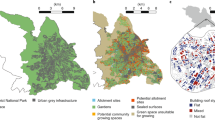Abstract
The growing popularity of urban horticulture is being driven by growth in urban agriculture in general. This is particularly prominent in urban inner cities areas sometimes characterized as “food deserts.” The motives for the urban agriculture movement in these areas are multifaceted. Critics who dismiss the movement for its lack of economic potential fail to understand that its social and cultural contributions are perhaps even more important than its significant contributions to intercity employment and food security. The urban agriculture movement is not new. Prior to the industrialization of agriculture, people in cities met many of their food needs from urban gardens and truck farms in peri-urban areas. The Garden City Movement of the late 1800s was a response to concerns for urban food insecurity that had resulted from reliance on the market-driven, industrial food system. Industrialization of agriculture, although successful in increasing production, had failed to provide domestic food security. Urban agricultural movements of the past have blossomed during times of food scarcity and income insecurity, particularly during times of war and economic recession. The current urban agriculture movement is different, in which it is continuing during times of agricultural abundance and economic sufficiency. Urban horticulture is more adaptable to urban areas than livestock or grain production. Thus, the current movement is commonly identified as an urban horticulture movement. The potential importance of the urban horticulture movement becomes readily apparent when it is viewed as part of the much larger sustainable agriculture or agri-food movement. Agricultural sustainability is not simply a matter of economic efficiency but also requires ecological, social, and economic integrity. Social and environmental benefits, which are prominent attributes of urban horticulture, are critical to agri-food sustainability. Lacking economic incentives, government policies will be essential to ensure the social and ecological benefits essential for agri-food sustainability. Past government policies supporting industrial agriculture have been justified as essential for food security, but have failed. The first condition of agricultural sustainability is to meet the basic food needs of the present—food security. The second requisite is to do so without diminishing opportunity for future generations. Government policies of the future should logically be redirected to ensure agri-food sustainability, including sustainable urban horticulture. Perhaps most important, the urban agriculture movement is empowering people in inner cities to take control of their own destinies. The urban agriculture movement exemplifies the ethics of social responsibility essential for agricultural sustainability.
Access this chapter
Tax calculation will be finalised at checkout
Purchases are for personal use only
Similar content being viewed by others
Notes
- 1.
Food and Agriculture Organization of the United Nations, “Urban Agriculture,” http://www.fao.org/urban-agriculture/en/.
- 2.
World Watch Institute, State of the World 2011, “State of the World Brief Series, Chapter 10, Feeding the Cities, http://blogs.worldwatch.org/nourishingtheplanet/wp-content/uploads/2011/02/Chapter-10-Policy-Brief_new.pdf?cda6c1.
- 3.
Raychel Santo Anne Palmer Brent Kim, “Vacant Lots To Vibrant Plots, A Review Of The Benefits And Limitations Of Urban Agriculture,” file:///C:/Users/John/Documents/Articles-Abstracts/Urban%20agriculture/urban-ag-literature-review.pdf.
- 4.
Geni, “The Garden City Movement,” https://www.geni.com/projects/The-Garden-City-Movement/15255.
- 5.
Wikipedia “Victory Gardens,” https://en.wikipedia.org/wiki/Victory_garden.
- 6.
CBS documentary, “Hunger in America,” 1968, https://www.youtube.com/watch?v=h94bq4JfMAA.
- 7.
Ikerd, Crisis and Opportunity, 2008.
- 8.
Greenbelt Administration, “Farming in Ontario’s Greenbelt; Opportunities Grow Here,” October, 2013, http://www.greenbelt.ca/farming_in_ontario_s_greenbelt_possibility_grows_here.
References
Colasanti K, Hamm M (2013) Increased productivity, role in alleviating food insecurity possible. J Agri Food Syst Community Dev 3(2):15–16. https://doi.org/10.5304/jafscd.2013.032.011
Coleman-Jensen A, Gregory C, Singh A (2013) Household food security in the United States in 2013 (Economic Research Report No. [ERR-173]), p. 41. http://www.ers.usda.gov/media/1565415/err173.pdf
Evans TL, Miewald C (2013) Cultivating more than food: Where community gardens fit with what cities do. J Agri Food Syst Community Dev 3(2):19–21. https://doi.org/10.5304/jafscd.2013.032.013
Hallsworth A, Wong A (2013) Urban gardening: a valuable activity, but …. J Agri Food Syst Community Dev 3(2):13. http://dx.doi.org/10.5304/jafscd.2013.032.010
Howard E (1902) Garden cities of to-morrow. Swan Sonnenschein & Co, London. https://archive.org/stream/gardencitiestom00howagoog
Ikerd J (2008) Crisis, and opportunity—sustainability in American agriculture. University of Nebraska Press, Lincoln, NE
Ikerd J (2012) The essentials of economic sustainability. Kumarian Press, Bloomfield, CT
Lavid L (2013) Urban gardens: Part of a whole system approach. J Agri Food Syst Community Dev. https://doi.org/10.5304/jafscd.2013.032.012 Advance online publication
McLean T (2017) Michigan state university extension, urban agriculture trend continues in 2017, 26 Jan 2017. http://msue.anr.msu.edu/news/the_urban_agriculture_trend_continues_in_2017
Mumford L (1961) The city in history, its origins, its transformations, and its prospects. Houghton Mifflin, Harcourt, New York. https://books.google.com/books/about/The_City_in_History.html?id=q0NNgjY03DkC
Royte E (2017) ensia, “Urban agriculture is booming, but what does it really yield?” 27 April 2017. https://ensia.com/features/urban-agriculture-is-booming-but-what-does-it-really-yield/
Smit J, Nasr J, Ratta A (2001) Urban agriculture: food jobs and sustainable cities (Chapter 2, edition, published with permission from the United Nations Development Programme). http://www.jacsmit.com/book/Chap02.pdf
Weissman E (2013) No buts about it … the value of urban food production. J Agri Food Syst Community Dev 3(2):24. https://doi.org/10.5304/jafscd.2013.032.014
Wojtowicz R (2001), City as community: the life and vision of lewis mumford, vol 4, issue 1. Quest, Old Dominion University, Jan 2001. http://ww2.odu.edu/ao/instadv/quest/CityAsCommunity.html
Author information
Authors and Affiliations
Corresponding author
Editor information
Editors and Affiliations
Rights and permissions
Copyright information
© 2018 Springer International Publishing AG, part of Springer Nature
About this chapter
Cite this chapter
Ikerd, J. (2018). The Role of Urban Horticulture in the Sustainable Agri-Food Movement. In: Nandwani, D. (eds) Urban Horticulture. Sustainable Development and Biodiversity, vol 18. Springer, Cham. https://doi.org/10.1007/978-3-319-67017-1_10
Download citation
DOI: https://doi.org/10.1007/978-3-319-67017-1_10
Published:
Publisher Name: Springer, Cham
Print ISBN: 978-3-319-67016-4
Online ISBN: 978-3-319-67017-1
eBook Packages: Biomedical and Life SciencesBiomedical and Life Sciences (R0)




